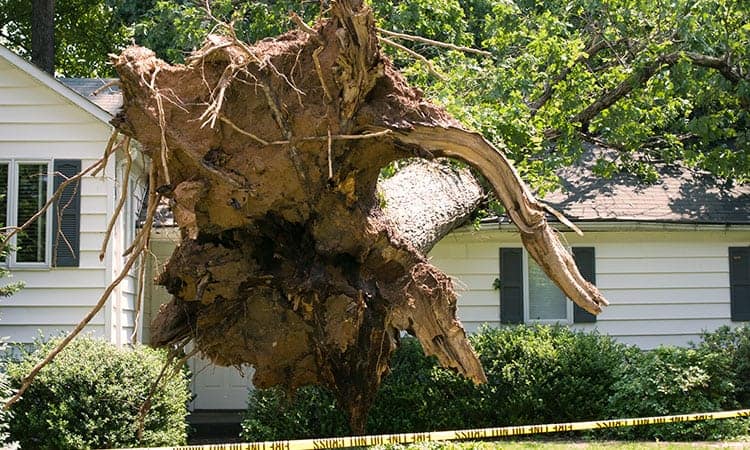As we remember the devastation of Hurricane Sandy nearly 5 years ago, we can’t help but consider what actions we as homeowners can take to protect our property from the next big storm. Storms are expensive. Not only in terms of damage and loss but also the expense associated with temporary living conditions. Insurance doesn’t typically cover all ancillary costs of evacuation or hunkering down without power.
There are some projects that can improve your home’s odds of functioning more efficiently during the next storm. Here are 8 things you can do to protect your home and your finances from potential disasters.
1. Trim Trees
Flying branches and falling trees are some of the most common — and expensive — causes of damage during a storm. And you may get stuck with a big chunk of the bill. Your homeowner’s insurance policy will generally cover damage to your home caused by trees, but it usually pays no more than $500 to $1,000 for tree removal, even though it can cost a few thousand dollars to clean up a fallen tree. Inspect the trees near your home to identify any branches that could come crashing down, and then hire a professional tree service to cut them back from your home.

2. Clean Gutters and Waterproof Your House
Remove leaves and other debris from your gutters, which can clog them and send water pouring down the side of your house or under the roof. And check for cracks that could let water into your house. A professional roofing contractor, like us :), can come to inspect your roof and make sure none of the shingles or tiles are damaged and that the vents are all sealed so wind-driven rain won’t enter your house.
Get a Backup Sump Pump
Recent heavy rains reminded people how important it can be to have a good sump pump, especially if you have a finished basement. If your sump pump stops working or gets overloaded, the water could pour into your house — and the damage may not be covered by insurance. Have a battery backup for your sump pump, in case the electricity goes out. Even better is to add a battery-powered sump pump as a second pump, which gives you twice the capacity.
Secure Your Yard
The grading of your yard can determine whether stormwater runs away from your home or into it. Damage from water that seeps through your walls or floors may not be covered by your homeowner’s insurance policy. Also, secure lawn furniture and other outdoor items before a storm arrives, so strong winds don’t turn them into projectiles.
Install Storm Shutters
Storm shutters can do a lot to protect your home from hurricanes and other big storms. You’ll need time to buy them and have them installed, so don’t wait until the last minute. Contact your homeowner’s insurer first to see what kind of shutters you would need to qualify for a discount on your premiums.
Prepare an Emergency & Go Kit
Put together an emergency kit that can help if you lose electricity during a storm. It should consist of a battery-operated radio (and extra batteries), and flashlights. Keep some extra cash in case ATMs are on the blink for a while, and keep a phone charger in your car. The Red Cross also recommends stocking a three-day supply of food and water for everyone in your house, a first-aid kit, and a seven-day supply of medications. See FEMA’s fact sheet on building a disaster supplies kit.
It’s also a great idea to put together a box or file that you can grab quickly if evacuated, including your insurance policies, contact information for your insurance company, agent and other emergency contacts, your home inventory, extra keys, powers of attorney, and other important financial and personal records.
Consider a Generator
Keeping the electricity running during a power outage can also help protect your home — by powering your alarm system, sump pump, and air conditioning. You may even get a discount on your homeowner’s insurance if you install an automatic standby generator, which runs on natural gas or propane and turns on automatically after detecting a power outage.
Get the Right Types and Amount of Insurance
Let your insurance company know about any home improvements that affect the cost to rebuild your home (many insurers limit your coverage to 125% or less of your insurance amount). Some insurers send an appraiser to your house to help estimate the replacement cost of your home; other agents or insurers will accept detailed information about the upgrades over the phone.
2 Types of Insurance you may want to consider:
Coverage for sewage backups. It isn’t unusual for heavy rains to overburden the stormwater system or for your sump pump to stop working during the storm season, causing water or sewage to back up into your house. The damage can be smelly and expensive, especially if you have a finished basement. Sewage-backup coverage isn’t included in most homeowners’ policies, but you can generally buy a rider to provide sewage-backup coverage. Ask your agent or insurer to see whether you’re covered.
Coverage for flood damage. Flood damage isn’t covered by homeowners insurance, but you can get a policy from the National Flood Insurance Program depending on the risk in your area. You can usually buy coverage through your insurance agent too.